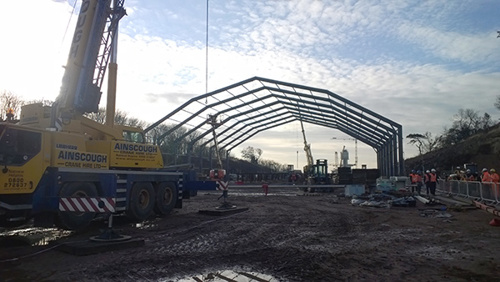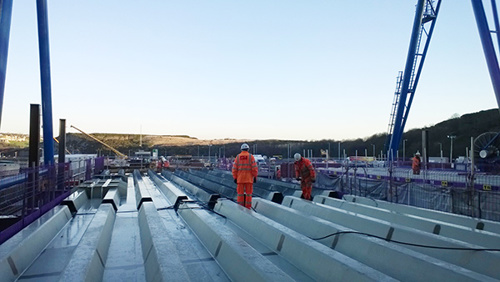West footpath/cycleway is currently closed for essential maintenance, please use the east footpath/cycleway.
Access RestrictionsHit the north: the "other" viaduct set to take the spotlight
12 December 2014It would be unfair to say the North Approach Viaduct (NAV) is the “forgotten” element of the Queensferry Crossing... you don’t simply forget an important part of a £790m bridge. But, you’ll forgive the poetic licence. For the past couple of years the visible, spectacular progress of the three towers and the South Approach Viaduct (SAV) has really captured the imagination .
All construction programmes are dynamic “live” documents, and the entire Forth Replacement Crossing scheme is more complex than most. There is continual review work and deployment of resources on the basis of efficiency and areas of most need. So, the NAV was not so much forgotten, as not needed just for the moment.

But not anymore. In recent weeks motorists travelling south on the A90 will have noticed a large structure – a bit like a huge greenhouse with no gable ends – off to the right just before they cross the Forth Road Bridge. Even more recently, the 20m high, blue gantry crane that hitherto had been helping piece together the SAV has now been taken apart, transported across the road bridge and re-assembled in the north. The NAV’s moment has arrived.
While the SAV has now been fully assembled, the final launch out across the piers has become less of a focus for the time being. Ironically, this is due to the speed in which the towers, in particular the North Tower, have risen. It’s amazing to think it was around 40m behind its southern and central siblings around a year ago and now it has caught up and moved fractionally ahead in the climb to their full 210m height. The cables will start to fan out from the towers next year and the priority now is to have the NAV in place to provide the necessary counter-balance to the cable-tensioned deck. In other words, the NAV needs to be there to provide anchorage against the upwards force of the cables.

The NAV will be made of steel and concrete and account for approximately 222m of the entire Queensferry Crossing bridge deck. It’ll stand on two v-shaped concrete piers, one land, one marine. The viaduct is split into two sections: a single steel box made of 12 welded together segments with a total length of 146m and a 76m-long twin trapezoidal steel box, similar to the SAV. The difference in the sections of the viaduct are again to do with anchoring the cables, the single box sections will ultimately be positioned over the two piers and contain the web panel anchorages which fix the stay cables coming from the North Tower.
Welding shed internal
The single box section is being fabricated at ZPMC in Shanghai and shipped, as components, to Rosyth over around a four month period. It will then be fully assembled in the North launch area situated just to the west of A90 at St Margaret’s Hope (where the Queensferry Crossing briefly makes landfall in the north before the new M90 will then be carried via the Ferrytoll viaduct north into Fife). The remaining element, the twin trapezoidal steel box, is being fabricated by Cleveland Bridge in Darlington and transported north in halves, also to be assembled on site. The project’s Principle Contractor, Forth Crossing Bridge Constructors, opted for this form of fabrication because transporting fully assembled segments on the existing north road network would have been a logistical challenge and far too disruptive for road users.
The decision to partially fabricate and assemble on site is where that greenhouse comes in. Cleveland Bridge is carrying out the full assembly on site – welding began in late November 2014 – underneath this temporary welding shed which provides a more controlled environment to allow the large sections to be put in place, welded and eventually painted. Concrete will also be poured in the last two twin boxes to act as a counterweight during the launch. Unlike the phased SAV launch, the NAV will be launched out over the piers in one continuous operation. This is likely to be carried out in the summer of 2015… we’ll have to make sure we’ve got the timelapse cameras in place for that one!


